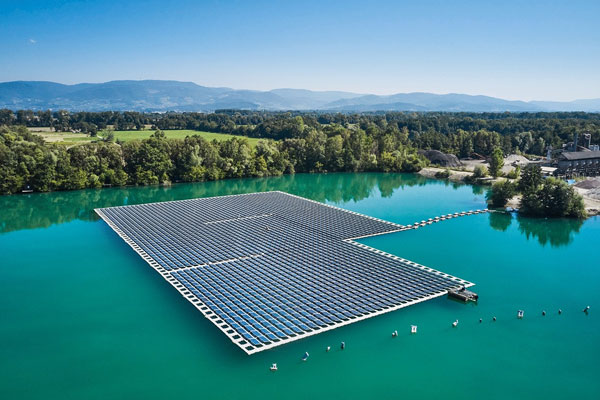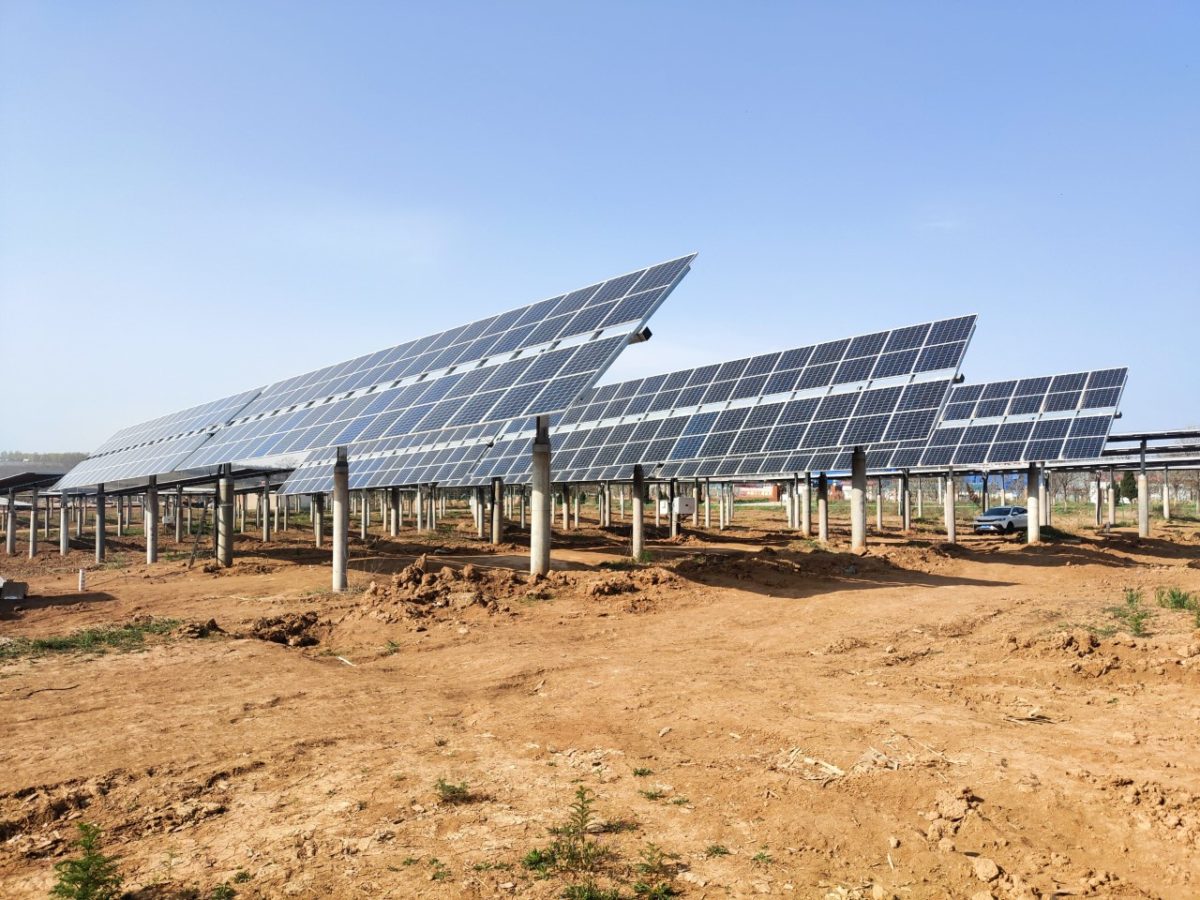New Types of Underlying Surfaces
Floating Solar Arrays on Lakes
Solar panels on lakes, or so-called “floatovoltaics,” is an innovative concept that enables the utilization of empty water surfaces for energy generation. A powerful example of this approach is the floatovoltaic installation on the Banasura Sagar reservoir in India. This deployment totals 6,000 square meters in area and possesses a capacity of 500 kW. Engaging in this dual-purpose activity, the system produces remarkable output in electricity while also preventing substantial water evaporation from the reservoir. Floatovoltaics can serve as a case-in-point model of efficiency in energy.
Integration with Aquaculture
Another illustration of technology’s adaptation into a broader and sustainable use is the combination of solar arrays with aquaculture. In this case, the solar panels are designed over an area populated with fish ponds or tanks. A case-in-point example of such engineering is a huge 300-hectare development in South Korea, where solar energy is generated over marine fish aquaculture. The technology helps to reduce the water temperature and, thereby, improve the growth rate of the fish and reduce the death rate because of heat-related issues. Such initiatives digitize the potential of energy production together with the production of food.
Enhanced Panel Performance with Cool Water
According to the data obtained from a similar system was installed in the Queen Elizabeth II Reservoir in London, and it demonstrates that the water can enhance the performance of the panels by cooling them naturally. It can boost the efficiency of the system by 10%, and the cooler temperatures can also extend the longevity of the technology. These developments are crucial for the improvement of energy output.
Challenges and Innovations with Mooring Solutions
The development of a successful mooring system is central to the qualification of a floating solar deployment. Multiple innovative solutions exist for this goal, with the most peculiar development being the use of tension-leg platforms used in offshore oil drilling. They are bolted down to the lakebed and move little, even without being hit by the strong wind.

Integration with Existing Ecosystems
Minimizing Ecological Footprints
Innovative floating solar technology is developed to minimize impacts on the aquatic ecosystems they occupy. For one, floating solar in Japan is designed with enough room between the panels for sunlight to get through to the water effectively, so the photosynthesis process for aquatic plants is not severely affected. As demonstrated through a project in the Hyogo prefecture, the spacing also resulted in less than 1% of the uniform growth compared to the areas outside the coverage. This example further demonstrates the developed methodology’s implementation in responsible technology.
Enhancing Biodiversity
Another benefit observed in selected projects is related to biodiversity, where the arrays are capable of providing artificial habitats that are hung under floating structures. By being attached to a floating platform, the construction allows life such as birds and rodents that are the food source for their predators to increase their population within arrays. An example of such project includes a lake in France, where floating platforms become equipped with nesting sites and shelters for some bird, bat and water species. This dual function observed does not comprise energy generation but adds up to wildlife protection.
Monitoring and Managing Water Quality
Since floating solar technology shades the water, the algae bloom and water temperature can be controlled accordingly. Continuous monitoring observed by California’s Napa County demonstrated the 20% decrease in chlorophyll a concentration, an indicator for the precipitate of algae occurence around the solar modules.
The defined methodics allows for repeatedly checking the water quality to ensure the ecosystem’s balance.
Sustainable Materials and Construction
Finally, the materials used for technological construction and development, such as HDPE, are environmentally friendly and 100% recyclable, lightweight and durable when it comes to high-density polyethylene. Moreover, the modular construction of models being purely assembled off-site and floated into positions adds to another economic side of using plastics.
All costs are minimized due to the minimally invasive installation and eventually result in cost-effective solutions.
Enhancements in Energy Efficiency
A pivotal element for optimizing the efficiency of energy production in floatovoltaic systems is the orientation of the panels. Novel tracking systems can monitor the position of the sun, thereby changing the slope of the panels’ placement and guaranteeing they are properly directed and exposed to the maximum amount of sunlight. For example, the use of automated tracking systems in a project in South Korea allowed increasing the energy output of the system by around 22%, which is significantly higher compared non-trackers.
Efficient use of the sun’s path ensures the highest level of energy exposure.
Cooling effects of water
The presence of water below the solar panels significantly affects the efficiency in regard to the climates in which the plants can operate. Studies showed that floating solar panels are on average 10-15% more efficient in electricity production compared to those located on the shore. In an example of such an installation in Tengeh Reservoir in Singapore, the system was observed to be 12% more efficient in electricity production compared to a nearby land-based system. The cooling effect increases the sustainability of the process.
Improved photovoltaic materials
Specific materials used for the placement of solar panels on water also boost the efficiency of floating systems. The use of bifacial solar panels, which are capable of gathering sunlight through their both sides, has been reported in several floatovoltaic projects. In general, such materials ensure the production of between 10% and 30% more energy compared to traditional monofacial panels, depending on the amount of light reflected by the surface of the water. In this regard, reflecting materials are used in each type of panel; however, when applied in floating systems, the efficacy of the bifacial components is increased.
Floatovoltaic systems combined with hydroelectric power plants is a novel approach. Such a combination allows the dual use of both sources depending on the amount of sunlight. That is, in the day time the plants operate on solar power and during the night or with low sunlight and during peak demand on hydroelectricity. The system at the Portugal Alto Rabagão Dam shows that the total energy output of the site is increased by the addition of a solar plant without the use of additional space.

Impact on Local Microclimate
Local Temperature Alterations
One of the direct effects of floating solar panels is their impact on local temperature profiles due to the coverage of significant water surface. For instance, a study on the Changhe Reservoir in China indicates that water areas covered by the devices decrease the temperature of surface water by about 2°C in sunshine conditions. Specifically, at such light, the shading of the reservoir’s surface by the solar panels creates a microclimatic cooling effect in the surrounding territory, which could be a boon in hotter regions. In other words, this demonstrates another benefit of the technology, constituting not only an energy source but an environmental tool as well.
Reducing Humidity and Evaporation
Since floatovoltaic systems are installed on water bodies, local humidity levels and evaporation rates remain directly affected by the presence of solar panels. In the case of the Lake Mead, Nevada, evaporative losses were observed to reduce in covered areas between 10% and 15%. Specifically, decreased solar penetration of water leads to lower temperatures and reduced evaporation rates. Therefore, operation of floatovoltaics would allow managing water resources effectively, which could also provide additional economic benefits from installing similar systems across the world.
Airflow Changes
Slightly disrupting airflow patterns over the water surface is another factor influenced by floatovoltaics. In other words, a study coupled with the simulation of the systems located at Yamakura Dam, Japan, demonstrates that wind speed and direction shifts only slightly in the areas of solar panels. Specifically, this means that seeds and pollen will also be distributed in a slightly different manner. However, resembling the aforementioned ones, it is important to recognize that catastrophic consequences will not be observed, even in the worst-case scenario. Still, the technology must be carefully managed, and the influencings ecosystems should be studied before widespread adoption.
Light-Distribution Consequences
Finally, the last impact to consider encompasses the effects of solvotaics on concentration and dispersion of light in some specific waters, which are inhabited by marine life that evolved under a certain amount of sunlight. Nevertheless, manufacturers try to tackle such issues through applying non-reflective coating and texture.
Future Directions in Lake-Based Solar Energy
Scalability and Larger Deployments
A large subset of emerging applications involves the process of scaling up from small pilot projects to larger, highly impactful installations. For example, the author states that given the current developments in Brazil, it can be expected that a 150 MW project in the Balbina Hydroelectric Dam reservoir will be launched very soon; enveloping thousands of square meters, the identified installation will be viewed “as a demonstration of the combination of hydroelectric and solar energies on a large scale”. In this case, the content will provide every premise for transferring the concept into a valid component of a national power grid.
Integration with Smart Grid Technology
According to the author, a potential avenue for the development of floatovoltaic systems includes the closer integration of the technology with smart grids. Its immediate effect implies more efficient distribution of electricity and better management of the network load as smart grid systems actively track and calculate the actual demand for electricity in a particular area, and use this information to adjust current production. For instance, Shirazi et al. discuss an ongoing project in California, where a floatovoltaic installation will be connected to a large AI-driven analytics center regulating the production and distribution of electricity.
Enhanced Environmental Compatibility
One of the less well-known areas of development is linked to innovations, aiming at further reducing the impact that floatovoltaic technology has on the local environment. For example, the above-mentioned design Coop 21 developed by UGE’s Benzo noted by the article includes a covering, made of transparent panels, enabling the sunlight to reach the water and plants growing at the bottom, thus creating a healthy ecosystem and is eco-friendly. Similarly, Benzo stresses the importance of finding eco-friendly solutions for the production of floats and anchors.
Development of Global Standards
Finally, the international prevalence of Lake-based solar energy production implies that global standards regulating its installation, maintenance, and safety will start to emerge. As suggested by Scrafton, international energy bodies, such as IEC, have already begun working in this direction.



